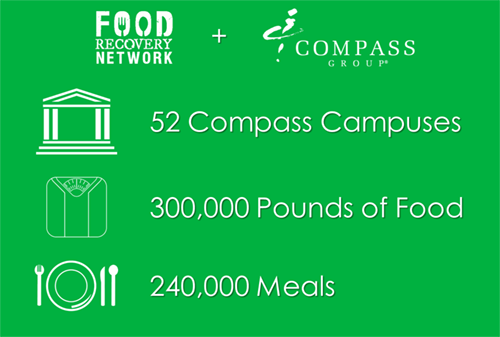Reducing Food Waste Across the Nation, One Campus at a Time
In the US, 40% of food goes uneaten and ends up rotting in landfills as the single largest component of municipal waste and accounts for 16% of methane gas emissions. In 2011, a group of University of Maryland students set out to change that.
One of those University of Maryland students and Food Recovery Network’s Co-Founder and Director of Development, Mia Zavalij, shares FRN’s story and their plans to make food recovery the norm, not the exception.
Jonathan Squibb: How did the Food Recovery Network get its start?
Mia Zavalij: In 2011, University of Maryland students noticed a paradox: dining halls were wasting nutritious food while community members were going hungry. The students formed Food Recovery Network (FRN) to address these problems through a student-driven mission: recovering surplus food from their campus and donating it to local nonprofits.
FRN’s replicable model caught on quickly as more students noticed the same issue in their respective communities and adopted FRN programs. Since its founding, FRN has scaled from one campus group to a network of 186 chapters in 42 states that have recovered more than 1.2 million pounds of food. By May 2017, FRN aims to reach 230 chapters and recover 1.6 million pounds.
FRN’s programs change not only the trajectory of would-be-wasted food but also the conversation about American food systems. FRN envisions a nation where food recovery is the norm, not the exception.
JS: When did you transition from needing to seek out chapters vs. potential chapters coming to you?
MZ: In the first year and a half, FRN’s student co-founders started 22 chapters through outreach to friends on other campuses. In the summer of 2013, FRN was featured on the VH1 Do Something Awards. We hired our first full time staff just in time to manage the tidal wave of new chapter applications; since then hundreds of students have expressed interest in bringing FRN to their campuses.
JS: How does a chapter get its start and how do you develop the partnerships with the community groups that receive the food?
MZ: Once a student expresses interest in starting an FRN chapter, they are paired up with a staff member at FRN national. FRN staff coach the students through an eight step process to start a chapter. Our steps include, recruiting a leadership team, talking with dining service managers, training in food safety, and finding an appropriate partner agency in the community to receive the food. FRN students have the autonomy to choose the partner agency that will work best for their chapter, and FRN national provides support in ensuring the partner meets necessary guidelines and has the capacity to properly store and reheat donated food.
 JS: How did the relationship with Compass Group begin?
JS: How did the relationship with Compass Group begin?
MZ: Early on, FRN formed a relation with Bon Appétit Management Company and Chartwells Higher Education. Claire Cummings, from Bon Appétit, helped develop the Food Safety Guidelines we use to train our students and a “Guide to Food Recovery for Kitchen Managers.” We have been very appreciative of the support that our partnerships with Bon Appétit and Chartwells have been able to provide. Through working together, FRN has rapidly spread to Compass accounts across the country, and we expect this growth to increase in the coming years.
On April 2-4 of this year, FRN hosted the inaugural National Food Recovery Dialogue, bringing together over 400 student leaders and professionals in the food recovery, food justice, policy and environmental spaces. Chartwells Higher Education was the Premier Sponsor for the National Food Recovery Dialogue and supported the travel of hundreds of students from all over the country, allowing FRN to bring together a record number of students for the weekend!
“We are so grateful for the travel stipend from Chartwells Higher Education which allowed us to send three members of our team to the Food Recovery Network dialogue. The conference helped us feel good about the work we’re doing while exciting and inspiring us to keep striving to accomplish more on our campus. We can’t wait to see where this national movement goes and are happy to be on board, we hope to attend the dialogue next year as well!” – Kirsty Hessing, student from FRN at Wagner College
JS: What’s next for FRN?
MZ: In less than five years, FRN has grown from a student group at the University of Maryland to the largest student movement against hunger and food waste with nearly 200 chapters in 42 states. As an expert in food recovery, FRN is currently exploring the impact it can have on accounts outside of college campuses while continuing to put higher education on track to be the first sector in the economy where food recovery is the norm.
Click here to learn more on Food Recovery Network’s website.
Photo Credit: Elena Baurkot